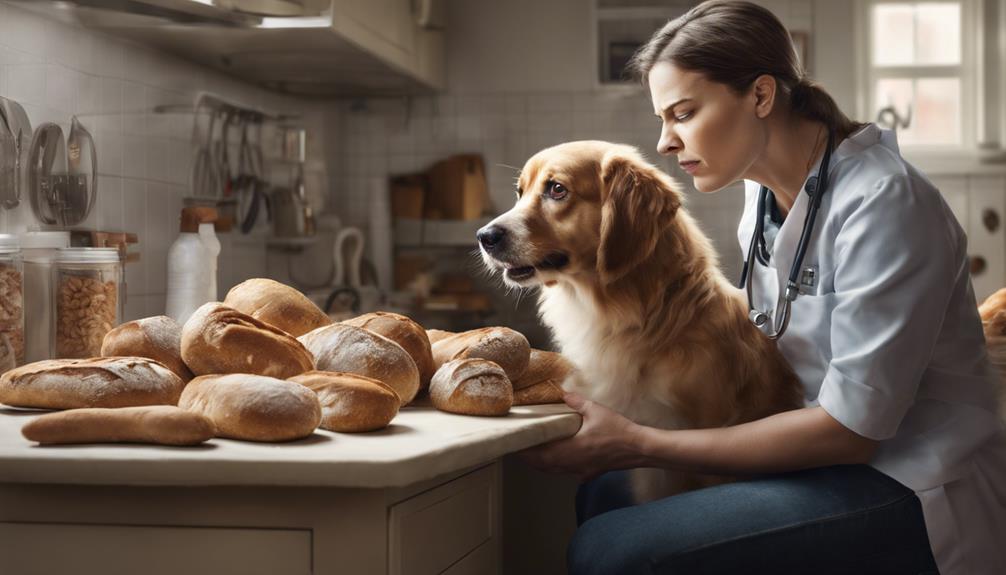Bread can be harmful to dogs as it lacks essential nutrients and may contain toxic additives. Harmful ingredients like nuts, chocolate, raisins, garlic, onions, and xylitol can lead to serious health issues. Dogs should avoid these additives to stay safe. Pay attention to bread labels and opt for plain varieties without harmful ingredients. Monitoring bread intake is important to prevent weight gain and health problems. When dogs consume bread with toxic components, they can experience vomiting, diarrhea, weakness, and even more severe symptoms. Understanding these risks helps keep our furry friends healthy and happy. For more insights into dog nutrition, explore further resources.
Key Takeaways
- Bread can lack essential nutrients for dogs.
- Harmful additives like raisins, garlic, and xylitol can be toxic.
- Excessive consumption can lead to weight gain and health issues.
- Opt for plain bread without harmful ingredients.
- Monitor bread intake to prevent health complications.
Risks of Feeding Bread to Dogs
Feeding bread to dogs poses risks due to its lack of essential nutrients and potential hazards from toxic additives. Bread, while a tasty treat for us, can lead to weight gain and health issues in our furry friends if consumed excessively.
Dogs should steer clear of bread containing toxic additives like nuts, chocolate, raisins, garlic, onions, and xylitol, as these can be harmful to their well-being. In fact, excessive consumption of bread can contribute to obesity, which brings along a host of other health problems for our canine companions.
To guarantee our dogs stay healthy and happy, it's important to prioritize a balanced diet consisting of high-quality dog food over indulging them with bread. By focusing on providing the right nutrients through their meals, we can help prevent the risks associated with feeding bread to dogs and promote their overall well-being.
Harmful Ingredients in Bread for Dogs

Certain ingredients commonly found in bread can be harmful to dogs. Raisins may lead to kidney failure, while garlic and onions can cause gastrointestinal issues and anemia in dogs. Xylitol, nuts, seeds, and chocolate are also toxic to dogs, potentially causing serious health issues.
Toxic Ingredients in Bread
Bread can pose serious risks to dogs due to the presence of toxic ingredients like raisins, grapes, garlic, nuts, seeds, and xylitol, an artificial sweetener. Raisins and grapes can lead to kidney failure, while garlic may cause vomiting, diarrhea, and damage to red blood cells. Nuts and seeds can trigger gastrointestinal issues and potentially pancreatitis in dogs. Xylitol is harmful, causing low blood sugar and liver damage.
It's important to check bread ingredients to prevent feeding harmful substances to dogs and safeguard their safety. Being aware of these toxic ingredients in bread can help protect our furry friends from serious health issues.
Bread and Dog Health
Examining bread labels for toxic additives is crucial to safeguarding the health of our canine companions. Dogs are vulnerable to harmful ingredients like raisins, grapes, garlic, onion, nuts, seeds, xylitol, chocolate, and artificial sweeteners commonly found in bread.
These additives can lead to severe symptoms such as vomiting, diarrhea, weakness, abdominal pain, pancreatitis, seizures, coma, or even death. To prevent health risks, always check bread labels for these toxic substances before feeding it to dogs.
Opt for safe options like plain white or brown bread without any harmful additives to guarantee your dog's well-being. By avoiding bread with toxic ingredients, you can prevent unnecessary health issues and keep your furry friend healthy and happy.
Bread Alternatives for Dogs
To guarantee the well-being of our canine companions, exploring bread alternatives that exclude harmful ingredients is important. When considering what dogs can eat, it's vital to avoid bread with nuts, seeds, artificial sweeteners, or excessive salt.
Opt for plain bread as a safer option for dogs compared to varieties with toxic additives. Instead of bread, consider offering fresh vegetables, lean meat, or high-quality dog treats as wholesome alternatives. These options provide natural ingredients that can help prevent potential health risks for our furry friends.
Monitoring Bread Intake in Dogs
When it comes to monitoring bread intake in dogs, it's crucial to pay attention to the portion size, types of bread, and potential health implications.
We need to be mindful of the quantity of bread we offer our furry friends, opt for bread free from harmful ingredients, and consider any adverse effects on their well-being.
Bread Portion Size
Keeping a close eye on the amount of bread your dog consumes is essential for their health and well-being. When it comes to bread portion size for dogs, remember these key points:
- Limit bread intake to small amounts to prevent weight gain and maintain a balanced diet.
- Monitoring intake is vital to avoid obesity and related health risks in dogs.
- Overindulgence in bread can lead to stomach upset, bloating, and other health issues.
Types of Bread
Monitoring the types of bread dogs consume is important to safeguard their health and well-being. While plain white and brown bread are generally safe for dogs in moderation, certain types should be avoided. Bread with toxic ingredients like garlic, onions, chocolate, raisins, and artificial sweeteners can be harmful to dogs. Seeded bread, which may contain harmful nuts and be challenging to digest, should also be kept away.
Varieties such as garlic bread, sourdough bread, and bread with various toppings are best avoided altogether. By monitoring bread intake in dogs, we can prevent potential health issues such as weight gain, stomach upset, and bloating. Ensuring your furry friends steer clear of these harmful bread types is essential for their overall well-being.
Health Implications
Shifting from discussing the types of bread suitable for dogs, we now focus on the health implications of monitoring bread intake in our canine companions. When it comes to our furry friends, keeping an eye on how much bread they consume is vital. Here are three key points to keep in mind:
- Weight Management: Excessive bread consumption can lead to weight gain and even obesity in dogs.
- Nutritional Concerns: Bread lacks essential nutrients for dogs, making it important to provide them with a balanced diet.
- Digestive Health: Monitoring bread intake is essential to prevent digestive issues and maintain a healthy weight in dogs.
Health Complications From Bread Consumption

Frequently, dogs can experience various health complications as a result of consuming bread. While a small piece of bread may seem harmless, it can lead to serious issues for our canine companions. Excessive bread consumption can contribute to weight gain and obesity in dogs, as it lacks the essential nutrients they need for a balanced diet.
Additionally, dogs may suffer from stomach upset, bloating, or constipation when they eat too much bread, causing discomfort and potential digestive problems.
Certain ingredients commonly found in bread, such as garlic, onions, or artificial sweeteners, can be toxic to dogs. These substances can cause harm to their red blood cells or lead to other serious health issues. Hence, it's important to be mindful of the ingredients present in the bread you're feeding your furry friend.
These health complications from bread consumption highlight the significance of providing dogs with a safe and appropriate diet tailored to their specific nutritional needs.
Types of Bread to Avoid for Dogs

To ensure the well-being of our furry friends, it's important to be mindful of the types of bread that should be avoided due to their potential harm. When considering your dog's diet, it's vital to steer clear of certain bread varieties that could be toxic or harmful to their health.
Here are three types of bread to avoid:
- White Bread: Opt for healthier options as plain white bread offers little nutritional value and can lead to weight gain if consumed regularly by your pet.
- Seeded Bread: Seeds in bread can cause digestive issues in dogs and may contain harmful nuts that are toxic to them. It's best to choose seedless varieties to prevent any potential complications.
- Garlic Bread: Garlic is known to be toxic to dogs and can cause stomach upset, weakness, and other health problems. Avoid feeding your furry companion any garlic-laden bread to keep them safe and healthy.
Immediate Veterinary Attention for Bread Ingestion

In cases where dogs ingest harmful bread ingredients, immediate veterinary attention may be necessary to address potential health risks. Symptoms of bread ingestion in dogs, such as vomiting, diarrhea, weakness, or abnormal behavior, could indicate toxic ingredients that may lead to serious health complications.
If your furry friend consumes bread dough or any toxic components, it's essential to contact a vet promptly for guidance and treatment. Early intervention by a veterinarian is key to preventing severe health issues that can arise from bread consumption in dogs.
Frequently Asked Questions
What Happens When a Dog Eats Bread?
When a dog eats bread, it can lead to weight gain and stomach issues like upset or bloating. Some bread ingredients, such as garlic, onions, and raisins, are toxic to dogs.
Excessive bread consumption can cause obesity and other health problems. To keep your dog healthy, it's important to avoid feeding them bread with harmful additives.
Be mindful of the portions and ingredients you give your furry friend to prevent potential health complications.
What Kind of Bread Is Toxic to Dogs?
Certain types of bread can be toxic to dogs, posing serious health risks. Ingredients like nuts, chocolate chips, raisins, onions, garlic, and xylitol are harmful to our furry friends.
Raisins can lead to kidney failure, garlic may cause anemia, and xylitol is highly toxic, leading to low blood sugar and liver failure. To keep our dogs safe, it's essential to avoid feeding them bread with these dangerous additives.
How Much Bread Can a Dog Eat?
We should limit bread in a dog's diet to prevent weight gain and health issues. Excessive consumption can lead to obesity and other problems. It's important to avoid bread with toxic ingredients like raisins, garlic, nuts, or xylitol.
Moderation is key for a dog's overall health. Remember, bread should only be an occasional treat and make up less than 10% of their diet. Be mindful of what you feed your furry friend to keep them healthy.
Does Bread Help Settle Dogs Stomach?
Bread isn't the best option for settling a dog's stomach as it lacks nutritional value. A bland diet of boiled chicken breast and rice is recommended over bread for upset stomachs in dogs.
Feeding bread to settle a dog's stomach may add unnecessary calories and contribute to weight gain. Dogs with upset stomachs may benefit more from a diet that's gentle on the digestive system, rather than bread.
Consult a vet for advice on the best dietary options to settle your dog's stomach instead of relying on bread.
Can Dogs Eat Bread if They Can Eat Peanuts?
Yes, dogs can eat bread safely but it’s crucial to avoid adding peanuts. Peanuts and dog safety are important to consider, as they can cause choking hazards and allergic reactions in dogs. Stick to dog-friendly foods and consult with a veterinarian for dietary recommendations.
Conclusion
Just like bread can be a tempting treat for us, it can also pose risks for our furry friends. Remember, moderation is key when it comes to sharing human foods with your dog.
Stick to dog-friendly treats to keep your pet healthy and happy. It's important to always prioritize your dog's well-being over their cravings, just like how we should always prioritize our own health over indulging in unhealthy snacks.










